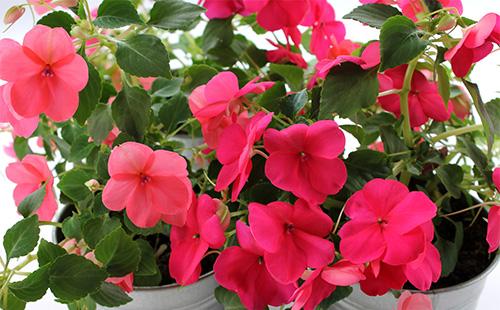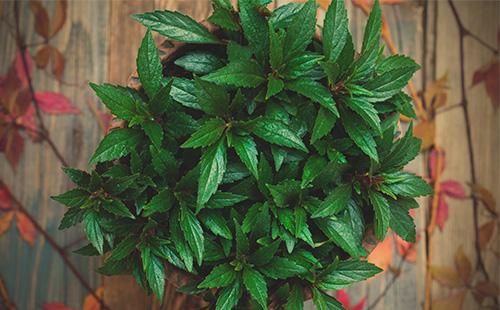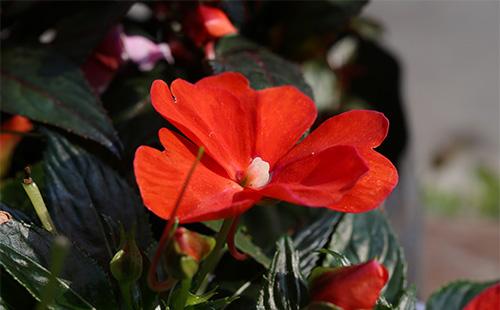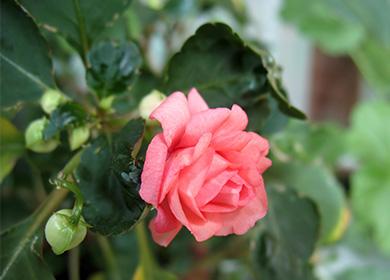The content of the article
Unlike other members of the family, the plant is large, but compact flowers can also be found. The height of the bush reaches 30-50 cm. The fleshy leaves have a bright color, starting with a bronze and ending with a dark green tint, the yellow middle. Their length is up to 10 cm, and their width is up to 5 cm. The presence of a strong stem of a reddish hue is also characteristic.
Large flowers with a diameter of 5-8 cm have regular shapes, painted in different colors - from white to red. On one bush there can be monophonic, two-ton or terry inflorescences. At home, flowering can last 12 months.
The main indoor views
A sufficiently large number of varieties has been developed. Each of them has its own characteristic height, leaf color, bud shape. Depending on the parameters, the following three groups are distinguished.
- Compact undersized bushes up to 20 cm high. They have small flowers. Great for breeding in pots on window sills, in greenhouses.
- Medium-sized sprawling flowers. They have the shape of a pyramid. Look very nice in hanging flower pots.
- Powerful bushes up to 50 cm high. Differ in erect shoots. In the interior, they are combined with other cultures, since they look scanty in solitude. Especially good in massive flowerpots.
There are several series that are recommended for home gardening. They are described in the table.
Table - Indoor types of New Guinea Balsam
| Title | Features |
|---|---|
| Harmony | - The branched bush of compact sizes; - large flowers of one of 14 colors; - leaves from green to bronze |
| Divaro | - Small bushes with strongly branching stems; - green leaves; - flowers of medium size 6 shades |
| Macarena | - Leaves of bronze-green color; - flowers of a bright orange hue |
| Jungle rain | - Pastel colors |
| Rainforest exotic | - Flowers painted in 2 colors |
| SunPatiens Spreading White | - Compact bushes with variegated leaves; - medium sized flowers in white |
You can also give preference to the sort of Java, which boasts a wide palette of shades of flowers. Or you can pay attention to the Mini Jini with abundant flowering.
New Guinean Balsam Care: What to Consider
Growing New Guinea balsam at home requires a few simple rules. With a competent approach, he will be healthy and beautiful.
Light and the best place
Hybrid loves light, but does not tolerate direct sunlight. Therefore, it is recommended to place it on the western or eastern side. It can stand even in dark places, but in this case the quantity and quality of flowering will suffer.
If the balsam of New Guinea does not bloom in autumn and winter, then it does not have enough daylight hours.Therefore, it should be extended to 14-16 hours. How to do it? Based on the reviews, an effective solution is the use of artificial light. There are special phytolamps which are absolutely safe for "impassable."
Temperature
The optimum temperature for a “Guinean friend” gardeners is 18-24 ° C. In the summer, he is able to tolerate heat, but only in conditions of regular watering. The plant can be taken out with the onset of spring. The main thing is that the difference between the temperature day and night is 5-8 ° C. At 12 ° C, “touchy” dies.
Humidity and watering
The humidity level should be 40-60%. In the summer, in extreme heat, you can put an open container of water next to a "touchy" container. It is recommended to use a spray bottle several times a week. The plant is watered two to three times a week.
In winter, the frequency of watering is reduced to once every 15-20 days. With a central heating system and a dry microclimate, the plant needs additional spraying. Filtered or boiled warm water is used. The procedure is performed in the morning and evening hours. You can increase the level of humidity using a tray in which pebbles or expanded clay is poured.
Although balsam can endure all hardships, it’s not worth acting on the principle of “Better to overfill than underfill”. It is necessary to moisten the soil regularly in small portions, which will help to avoid stagnation of water. The main sign of excessive watering is the formation of green moss on the surface of the soil. If there is not enough of it, the “untouchable” will fade.
Soil and top dressing
The soil should be moderately nutritious, loose and light. Acidity (pH) in the range of 5.8-6.2. You can use a ready-made substrate for home crops from the store. A drainage layer must be present. If you prepare the soil yourself, then the following components are suitable:
- sheet earth;
- humus;
- sand.
They are taken in equal parts and mixed to a homogeneous mass. In the finished mixture, you can add vermiculite, expanded clay chips.
During the flowering period, “undercuts” are fed with mineral complexes of low concentration every two weeks. In winter, you can completely refuse additional food. It is convenient and easy to feed the plant, if you use liquid products diluted in water for irrigation. It is recommended to give preference to complexes with a high content of potassium and phosphorus.

Pinching and transplanting
Trimming is not worth it, as it will lead to the appearance of thick and ugly "hemp". Only young tops nibble once every one and a half to two years. In principle, the hybrid itself perfectly forms a beautiful shape. An exception is the Harmony variety, which needs pruning.
Having decided to transplant the "undersized", the gardener pays special attention to choosing a pot. Selected capacity in size slightly larger than the previous version. It should completely cover the roots and be tight. This approach will provide the balsam with lush and plentiful flowering. The plant does not have a dormant period, so it is transplanted at any time every year. But it is recommended that you choose early spring. The procedure is carried out in six stages.
- A few hours before transplanting, we moisten the soil well.
- We are preparing a new primer for balsam of New Guinea.
- We extract the plant and shake the ground from the roots.
- In a new container we prepare a layer of drainage and soil, put a bush on top.
- We close the roots, slightly tamp.
- Water with a little water.
Breeding methods
"Touchless" propagated by cuttings or seeds. The first method is the most popular, as it allows you to save all the decorative properties and maternal characteristics.
Vegetative
Features. Propagation of balsam of New Guinea cuttings is carried out in spring or early summer. Young plants are best planted in flowerpots 9-12 cm in size. Two weeks after the procedure, the cuttings will take root. Flowering can be expected in 60-90 days.
Procedure
- With a sharp knife, cut off the top of the shoot with three internodes.
- Cuttings 8-11 cm long are placed in a pot with peat and sand, which are mixed in equal portions.
- To quickly root the New Guinean balsam, flowerpots are covered with polyethylene - the effect of a greenhouse is created.

Seeds
Features Sown seeds in February or March in peat land. Seedlings can be planted only when their height is 4 cm. Two leaves are required. Flowering can be expected in 85-120 days.
Procedure
- Pre-seeds are kept in a solution of potassium permanganate for ten minutes.
- After sowing, the soil is moistened, covered with a film.
- A seed container is placed in a warm place with good lighting.
- Two weeks later, when shoots appear, the film is removed.
Possible problems
In most cases, plant diseases are the consequences of improper care. The main ailments, problems, and why they appear are described below.
- Drooping leaves. Most likely the temperature is elevated and there is not enough moisture in the soil. Often water the "touchy", carefully ventilate the room.
- The leaves turn yellow, dry and fall off. A lot of moisture and low temperature. Put the pot in a warmer place and adjust the frequency of watering.
- Flowers and buds fall off. Or do not appear at all. Not enough light, dry and hot air. Prevent temperature spikes, do not overfeed. Place the flowerpot in a well-lit area.
- Leaves do not grow and turn pale. The size of the pot is not correctly selected. The problem appears due to a lack of recharge and light. Transplant the “touchy” into a large container, providing good lighting and regular top dressing.
- Leaves curl. The plant is in cold and damp. Move it to a warmer and drier place.
- Weak flowering. Incorrect feeding. Reduce the dosage of fertilizers containing nitrogen.
- Light spots on the leaves. The plant received sunburn or was sprayed with hard water. Put the pot away from direct sunlight, use only filtered water for irrigation.

Pests
Often, pests appear only when the conditions of the plant are not respected. If the room has dry air, then there is a high probability of being affected by a spider mite. He entangles the "undersized" web and sucks the juice from the plant. Often there are thrips. With a weak lesion, balsam is sprayed with alcohol or a soapy solution. If there are a lot of pests, then a ready-made insecticidal composition will help.
You can observe how small white flies appear on the "touch" whiteflies. Folk remedies will not help here. Treatment is best done with drugs. An insect adhesive tape that hangs near a flower helps.
When admiring a New Guinean green friend, do not forget to periodically inspect the leaves for insects. Pay attention to the soil and make sure that there is no green moss. How to care for balsam New Guinea, so that he "thanked" the lush and long flowering? Enough to pay attention to him. And then in room conditions he will be able to live up to five years.

